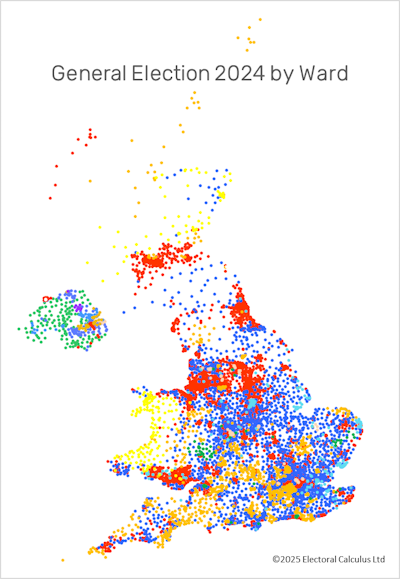With the new year, Electoral Calculus has updated some of our key datasets. The three main changes are:

In a major project, we have refreshed and recalculated our estimates for the 2024 general election result broken down by ward and census output areas.
There are over 8,000 wards and over two-hundred thousand census output areas, and these small areas are very useful for campaigners, researchers and others to understand UK political geography. Since the general election results are only officially published at constituency level, we have to make our own estimates of the results for smaller geographic areas.
We do this using a combination of data and methods, including:
Additionally, in Northern Ireland we use special techniques to infer ward-level voting patterns from the actual results by DEA (district electoral areas).
The Scottish authorities have now published the Scottish census data from 2022 at output area level. This has now been added to the Electoral Calculus database.
Please note that this release includes all census fields, except for approximate social grade (class), and measures of deprivation, which have not been published yet.
You can see some of the results at our data map, and for any seat in Scotland.
Each year the Local Government Boundary Commission for England revises the ward boundaries for some of the local councils in England. This year, the following seven councils have new wards:
| Council | Old Ward | New Wards |
|---|---|---|
| Buckinghamshire | 49 | 49 |
| Durham | 63 | 51 |
| North Northamptonshire | 26 | 31 |
| Northumberland | 66 | 69 |
| Shropshire | 63 | 72 |
| Thurrock | 20 | 20 |
| West Northamptonshire | 31 | 35 |
| Total | 318 | 327 |
The Electoral Calculus website has been updated to show the new 2025 wards both when viewing individual seats, and also when using tools like the data map.
All these councils are scheduled to have local elections under the new wards on 1 May 2025. Please note that Thurrock council has requested a delay for its election as part of potential local government re-organisation.
For clarity, we have also changed our decomposition of the City of London away from the 25 historic wards (some of which are almost unpopulated) to use instead the four polling districts of the City. We have also merged the five parish wards in the Isles of Scilly into one larger hypothetical ward, since some of the parishes were quite small.